Baby bottle
A baby bottle, or nursing bottle, or feeding bottle, is a bottle with a teat (also called a nipple in the US) to drink directly from. It is typically used by infants and young children, or if someone cannot (without difficulty) drink from a cup, for feeding oneself or being fed. It can also be used to feed non-human mammals.
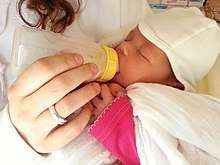
In particular it is used to feed infant formula, expressed breast milk or pediatric electrolyte solution.
Dimensions and design
A large-sized bottle typically holds 280 ml; the small size 150 ml. It is composed of a bottle itself, a teat, a ring to seal the teat to the bottle, a cap to cover the teat and optionally a disposable liner.
The height-to-width ratio of bottles is high (relative to adult cups) because it is needed to ensure the contents flood the teat when used at normal angles; otherwise the baby will drink air. However, if the bottle is too tall, it easily tips. There are asymmetric bottles that ensure the contents flood the teat if the bottle is held at a certain direction.
A typical baby bottle typically has four components. A teat, or nipple, is the flexible part of the bottle that the baby will suck from, and contains a hole through which the milk will flow. The collar goes over the nipple and typically screws onto the neck of the bottle, forming a seal. Most, but not all baby bottles will also have a cap or travel cover that goes over the teat to keep it clean and to prevent small spills.[1]
Teats (or nipples)
The teat itself is generally designed to be slimmer than the mother's nipple. Specialized teats are marketed that report attempting to mimic the shape of the breast to help babies to switch back and forth between bottle feeding and breastfeeding for cases where "nipple confusion" occurs.[2]
Teats come in a selection of flow rates, marketed to be based on the age of the infant. Different flow rate teats either have more holes or larger holes. Variable flow rate teats are available for older infants. The hole is asymmetric so that by turning the bottle/teat, different flows can occur. Specialized teats are available for infants with cleft palate.
Vented bottles
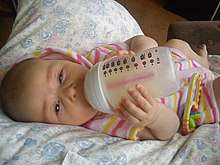
"Vented" bottles allow air to enter the bottle while the baby is drinking without the need to break the baby's suction during feeding. Alternatively a bottle liner can be used to enclose the formula instead of directly in the bottle. The liner collapses as the formula is drained.
Vented bottles work by allowing air to enter while preventing the liquid inside from escaping. It works by an "anti-vacuum skirt" in the base of the teat, where it forms a seal with the bottle. The skirt acts as a one way valve, allowing air to enter the bottle but not liquids to leave. If the sealing ring is tightened too much, the skirt is compressed too tightly to allow it to open and the bottle will not vent. If the sealing ring is too loose, liquid leaks from the bottle.
There are multiple patents for technologies in this area. Initial designs called for a complex spring and valve system that was impossible to clean and sterilize. Current research is in specialized materials with microscopic pores that allow the entry of air without the escape of liquids. This avoids the caregiver having to get the sealing ring tension just right. It remains to be seen whether these materials can withstand the rigours of daily cleaning and sterilization. Another competitor, Dr. Brown's, offers a system whereby the vented air is conducted through a tube to the bottom of the bottle where the airspace is when the bottle is in use. This avoids the vented air from bubbling through the liquid and unnecessarily aerating the liquid. The aeration may cause nutrients in "human milk and infant formula (to) decrease in concentration . . . to a level that may be clinically significant".[3]
Variations and accessories
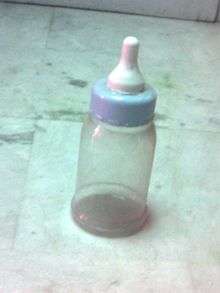
Bottles may be designed to attach directly to a breast pump for a complete "feeding system" that maximizes the reuse of the components. Such systems include a variety of drinking spouts for when the child is older. This converts the bottle into a sippy cup, a cup with lid and spout for toddlers, which is intermediate between a baby bottle and an open top cup. Bottles that are part of a feeding system may include handles that can be attached. The ring and teat may be replaced by a storage lid.
Accessories for bottles include cleaning brushes, or bottle brush, and drying racks. Brushes may be specially designed for a specific manufacturer's bottles and teats.
Bottle warmers warm previously made and refrigerated formula. Coolers designed to fit a specific manufacturer's bottles are available to keep refrigerated formula cold. Special formula powder containers are available to store pre-measured amounts of formula so that caregivers can pre-fill bottles with sterile water and mix in the powder easily. The containers are typically designed to stack together so that multiple pre-measured amounts of formula powder may be transported as a unit.
Institutions can purchase ready-to-feed formula in containers that can be used as baby bottles.[4] The lid screws off and is replaced by a disposable teat when the formula is ready to be used. This avoids storing the formula with the teat and possibly clogging the teat holes when formula is splashed within the bottle and dries.
Some bottles have been specifically designed to reduce colic in babies but there is little evidence that these actually do any good. The bottles are designed to minimize the intake of air during feeding.[5]
Use
Cleaning and sterilization
In the UK, the current advice given by NHS Choices remains to sterilize baby bottles,[6] which is deemed as especially important for newborn and high-risk infants (i.e., those susceptible to infection). Sterilization is also recommended in Australia, such as by Milton sterilizing fluid.[7] A current recommendation in the US is that bottle sterilization can be replaced by cleaning with hot soapy water.[8]
By age
Nipples (teats) are typically subdivided by flow rate, with the slowest flow rate recommended for premature infants and infants with feeding difficulties. However, flow rates are not standardised and vary considerably between brands.[9][10] The use of bottles is discouraged beyond two years of age by most health organisations as prolonged use can cause tooth decay.[11] The NHS recommends a sippy cup or beaker be introduced by 6 months and the use of bottles discontinued by 1 year.[12] The AAP recommends that the cup be introduced by one year of age and that the use of the bottle by discontinued by 18 months.[13]
Regulation
While infant formula is highly regulated in many countries, baby bottles are not. Only the materials of the teat and bottle itself are specifically regulated in some countries (e.g. British Standards BS 7368:1990 "Specification for babies' elastomeric feeding bottle teats"[14]). In the USA, the Food and Drug Administration (FDA) also regulates teats[15] and the bottle materials. In 1985 it tightened allowable levels of nitrosamines released from bottle teats.[16] A 1999 Consumer Reports study suggested that some polycarbonate bottles release unsafe amounts of Bisphenol A; however industry critics contented the study demanded unreasonable conditions to which the bottles were subject.[17][18] Findings since, however, have renewed the initial concerns (see Bisphenol A - Possible Health Risks).[19][20][21]
In 2011 use of bisphenol A in baby bottles was forbidden in all EU countries.[22] From 2012, other countries started following the American Food and Drug Administration's initiative to regulate baby bottles. For instance, Argentina, Brazil and Ecuador now prohibit bisphenol A in baby bottles. Korea extended the regulation to a list of five chemicals, now banned from all children's products including baby bottles.
History
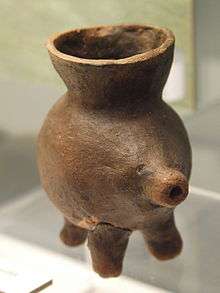
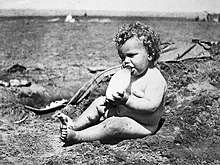
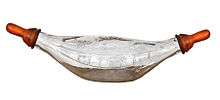
Bottles with hard spouts date to early in recorded time, as evidence by archeological finds (see image).[23][24][25] The first consisted of urns made of various materials, with an opening at one end for filling the bottle, and a second at the other to be put into the baby's mouth.[24] Animal horn was another common early material (dating to the 13th century, ibid.), examples of which survive as images in woodcuts. Soft nipples of various materials were introduced early in the history of feeding (e.g., leather, or dried cow's teat filled with cloth);[26][27] many were very difficult to clean.
Although Elijah Pratt of New York patented the first rubber nipple in 1845,[23] it took until the 20th century before materials and technology improved sufficiently to allow manufacture of a soft nipple that was practical for use: the invention of vulcanized rubber (1840s) provided a material that was soft and could eventually be manufactured in volume (early 1900s),[28] and could withstand the heat of sterilization. (As these sources note, "early black Indian rubber... had a very strong pungent smell", and did not survive repeated exposures to hot water.)
The first glass nursing bottle was patented by American C.M. Windship in 1841, but required that it "be superimposed on the mother's breast so that the nursing infant would be deceived into thinking that the milk was coming directly from the mother".[29] As the group American Collectors of Infant Feeders notes, by "the late 1800s a large variety of glass nursing bottles were produced in the United States", and the U.S. Patent Office had issued more than 200 patents for various designs of nursing bottles by the 1940s—designed to lie flat or stand up straight, with openings on their sides or ends, with detachable or permanently attached nipples, etc.[29] The American and British markets eventually saw the introduction of heat-resistant upright Pyrex bottles, narrow-necked versions in the 1950s and wide-neck versions a decade later,[30] with plastic bottles appearing widely, a further decade on.
Innovations such as the introduction of a working check valve in the nipple (to provide unidirectional flow of the liquid food) appeared as early as 1948 in a patent to J.W. Less,[31] and was picked up by others including Owens-Illinois Glass,[32] eventually making its way into Gerber and all modern pressure-balancing bottle designs,[33] as well as adult drinking cups and various other products requiring fluid flow under vacuum.[34]
The modern business of producing bottles in the developed world is substantial: in 1999 it was reported that the UK "feeding and sterilising equipment sector ... stands at £49m… [where] [s]ales of feeding bottles account for 39%" or £19.1m of that market.[35]
Controversy
The 2014 summary policy statement of the American Academy of Pediatrics (AAP) makes no specific mention of bottle feeding, but makes clear that "[b]reastfeeding and human milk are the normative standards for infant feeding and nutrition", and refers to decisions regarding the supply of infant nutrition as "a public health issue and not only a lifestyle choice… [g]iven the documented short- and long-term medical and neurodevelopmental advantages of breastfeeding".[36][37] The AAP policy recommends breastfeeding exclusively for six months, continuing it with introduction of complementary foods, with an overall duration of "1 year or longer as mutually desired by mother and infant".[37] The body of the policy statement notes and cites literature indicating that, in addition to the importance of mother's milk, the manner of the food delivery has implications: that "breastfed infants self-regulate intake volume", whereas bottle-fed infants receiving expressed breast milk or formula have "increased bottle emptying, poorer self-regulation, and excessive weight gain in late infancy", and that such early practice of self-regulation correlate with adult patterns of weight gain (ibid.).
The AAP policy notes that "[m]edical contraindications to breastfeeding are rare".[37] The transmission of some viral diseases through breastfeeding is reportedly preventable, e.g., by expressing breast milk and subjecting it to Holder pasteurization.[38]
In response to public pressure felt from policies de-emphasizing bottle- and formula-feeding, efforts have arisen to support mothers experiencing physiologic or other difficulties in breastfeeding, and sites include individual views that attempt to weaken the scientific case of the AAP policy;[39] a book of the personal experiences and views of one mother committed to bottle/formula feeding, Bottled Up, by Suzanne Barston, has appeared.[40]
See also
References
- "How to Clean, Sanitize, and Store Infant Feeding Items". CDC.gov. 2018-10-31. Retrieved 2020-05-22.
- "Nipple Confusion - Ask Dr Sears® - The Trusted Resource for Parents".
- http://www.reeis.usda.gov/web/crisprojectpages/213448.html
- "Homepage". www.smanutrition.co.uk.
- "Colic". Dr Tal Ditye @ Mommyhood101.
- "Bottle feeding advice". www.nhs.uk.
- "Bottle Feeding" (PDF). wch.sa.gov.au. Women's and Children's Hospital and Government of South Australia. Archived from the original (PDF) on 2011-04-23. Retrieved 2016-04-01. Printed November 2008
- "Should You Sterilize Your Baby's Bottles?". WebMD. Reviewed by Roy Benaroch, MD on May 24, 2014
- "Know the flow, don't go with the flow! by Britt Pados PhD(c), RN, NNP-BC, bpados@email.unc.edu". Pediatric Feeding News. 2014-06-08. Retrieved 2018-12-27.
- Pados BF, Park J, Thoyre SM, Estrem H, Nix WB (2016). "Milk Flow Rates from bottle nipples used after hospital discharge". MCN: The American Journal of Maternal/Child Nursing. 41 (4): 237–243. doi:10.1097/NMC.0000000000000244. PMC 5033656. PMID 27008466.
- Lisa Enger, RN, BSN, IBCLC. "Patient education: Weaning from breastfeeding (Beyond the Basics)". www.uptodate.com. UpToDate. Retrieved 2018-12-27.CS1 maint: multiple names: authors list (link)
- "Drinks and cups for babies and toddlers". nhs.uk. 2017-12-21. Retrieved 2018-12-27.
- "Weaning from the Bottle". www.aap.org. American Academy of Pediatrics. Retrieved 2018-12-27.
- "BSI British Standards Index". bsonline.techindex.co.uk. Archived from the original on 2011-05-13.
- https://www.fda.gov/fdac/features/095_quiz.html
- Affairs, Office of Regulatory. "Manual of Compliance Policy Guides". www.fda.gov.
- http://www.fumento.com/babybottle.html
- "Food Containers Made with Polycarbonate Plastic". www.plasticsinfo.org. Archived from the original on 2003-10-02. Retrieved 2003-12-06.
- "Baby Bottles and Bisphenol A (BPA)". HealthyChildren.org.
- Kay, Jane (24 June 2011). "SAN FRANCISCO / Lawmaker wants state to follow city's lead with 'toxic toy' ban / Bill would bar certain chemicals in products". The San Francisco Chronicle.
- "Scientists warn about plastic in baby bottles". Chicago Tribune. 3 August 2007.
- "Umstrittene Chemikalie: EU-Behörde senkt Grenzwert für Bisphenol A" (in German). Der Spiegel. January 21, 2015. Retrieved January 21, 2015.
- Bogucki, E. (2007). History of Nursing Bottles. American Collectors of Infant Feeders (a non-profit organization publishing information on the feeding of infants throughout history). Archived from the original on July 1, 2017. Retrieved February 27, 2014.
- "The Early Feeders". The Baby Bottle Museum. UK. 2011. Archived from the original on 2015-05-08. Retrieved February 27, 2014.
- Dunne, J.; Rebay-Salisbury, K.; Salisbury, R. B.; Frisch, A.; Walton-Doyle, C.; Evershed, R. P. (2019-09-25). "Milk of ruminants in ceramic baby bottles from prehistoric child graves" (PDF). Nature. 574 (7777): 246–248. doi:10.1038/s41586-019-1572-x. ISSN 1476-4687. PMID 31554964. Lay summary – DW.COM (2019-09-25).
- The Baby Bottle Museum, UK, 2011, "The History of the Feeding Bottle", "Archived copy". Archived from the original on 2014-01-31. Retrieved 2014-02-27.CS1 maint: archived copy as title (link)
- "and "The Early Feeders" Accessed February 27, 2014". Archived from the original on 2015-05-08. Retrieved 2014-02-27.
- Here and following see: The Baby Bottle Museum, UK, 2011, "The History of the Feeding Bottle", "Archived copy". Archived from the original on 2014-01-31. Retrieved 2014-02-27.CS1 maint: archived copy as title (link) and E. Bogucki, 2007, "History of Nursing Bottles", American Collectors of Infant Feeders, www.acif.org/past.html. Accessed February 27, 2014.
- E. Bogucki, 2007, "History of Nursing Bottles", American Collectors of Infant Feeders, www.acif.org/past.html. Accessed February 27, 2014.
- The Baby Bottle Museum, UK, 2011, "The History of the Feeding Bottle", "Archived copy". Archived from the original on 2014-01-31. Retrieved 2014-02-27.CS1 maint: archived copy as title (link). Accessed February 27, 2014.
- U.S. patent 2442656 A, "Nursing nipple for bottles", American J.W. Less in 1948 (www.google.ca/patents/US2442656, accessed February 27, 2014)
- U.S. patent 2747573 A, "Valved nursing nipple", issued to W.A. Schaich of Owens-Illinois in 1956 (www.google.ca/patents/US2747573, accessed February 27, 2014)
- E.g., see U.S. patent 6032810 A, "One-piece nipple/collar for nursers and the like", issued to the Americans M.A. Gilbertson, B. J. Meyers, E.A. Raleigh, and M.S. Stowe of Gerber Products Company in 2000 (www.google.ca/patents/US6032810), and U.S. patent 20120248056 A1, "Teat unit", issued to the Swiss R. Fischer, E. Furrer, and B. Emmenegger of Medela Holding Ag in 2012 (www.google.ca/patents/US20120248056). Accessed February 27, 2014.
- E.g., see U.S. patent US 7775394 B2, "Opening-force-maximizing device of an underpressure-activated valve for a drinking container", issued to the Norwegian K. Næsje of Smartseal As in 2010 (www.google.ca/patents/US7775394). Accessed February 27, 2014.
- "Archived copy". Archived from the original on 2009-07-27. Retrieved 2006-09-21.CS1 maint: archived copy as title (link)
- "American Academy of Pediatrics, AAP Policy on Breastfeeding and Use of Human Milk, see www2.aap.org accessed February 28, 2014". Archived from the original on 2014-04-25. Retrieved 2014-02-28.
- American Academy of Pediatrics, Policy Statement, Breastfeeding and the Use of Human Milk, Pediatrics 2012, 129(3), e827-e841 (doi: 10.1542/peds.2011-3552), accessed February 28, 2014.
- Tully DB, Jones F, Tully MR (May 2001). "Donor milk: what's in it and what's not". Journal of Human Lactation. 17 (2): 152–5. doi:10.1177/089033440101700212. PMID 11847831.
- "Fearless Formula Feeder - Infant Feeding Support". www.fearlessformulafeeder.com.
- Barston, S. (2012). Bottled Up: How the Way We Feed Babies Has Come to Define Motherhood, and Why It Shouldn't. University of California Press. ISBN 9780520270237. Retrieved February 28, 2014.
External links
| Wikimedia Commons has media related to Baby bottles. |
- History of the feeding bottle
- Babycentre.co.uk Step-by-step guide to bottle-feeding baby.
- mommypapa.me baby bottles.